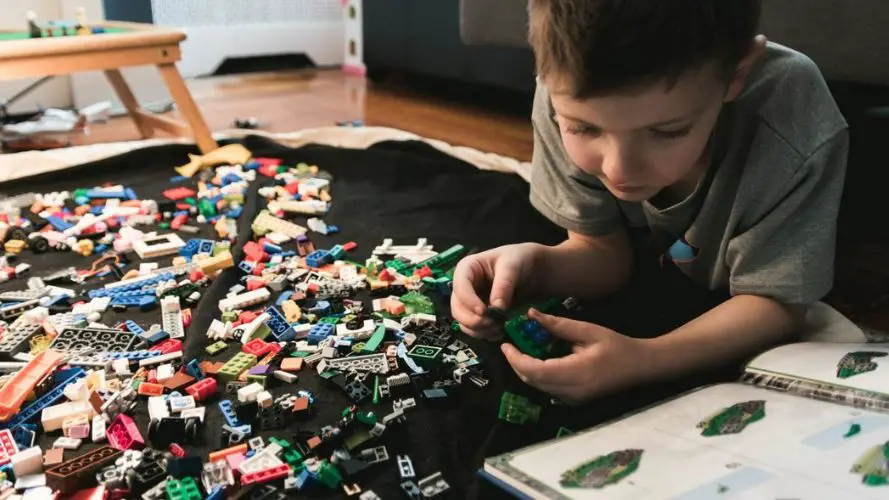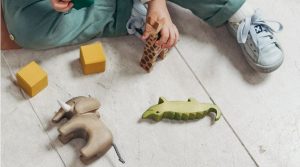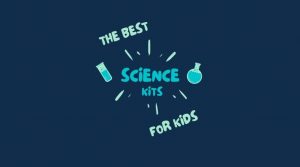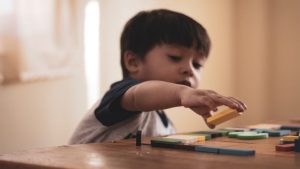Building towering creations and telling stories with LEGO blocks has long been a favorite playtime activity for kids, with the only hazard being an errant brick stepped on by mom or dad. As it turns out, science backs the importance of just the sort of construction play that LEGOS encourage; they, and other building block sets, can offer physical, mental, and social developmental boosts while playing.
For children with ASD, the benefits run even deeper. LEGO therapy has been shown to significantly aid the development of healthy social behavior when compared to other non-play therapies, a breakthrough that indicates many possible future applications for the therapy method.
Eager to learn which skills they’re building along with their towers, farms, bridges, and castles? Let’s take a look at the scientifically proven benefits of construction play.
The infographic

Block play benefits: Examining the evidence
#1 Improves spatial reasoning
The use of spatial reasoning allows children to imagine an object in three dimensions in their mind, conceptualizing about its size, shape, and how it would look when moved or rotated. It’s a skill that’s strongly correlated with mathematical ability, and some children are naturally better at it than others.
The use of spatial language and interaction with objects during construction play are both associated with boosts in spatial reasoning skill. In a 1999 study on the relationship between block play and visual-spatial skills in preschoolers, 51 children were assessed as they engaged in free and structured construction play with blocks. Play patterns emerged which indicated skill boosts in both spatial visualization and visual-motor coordination.
Key study/paper: Caldera, Yvonne & Culp, Anne & O’Brien, Marion & Truglio, Rosemarie & Alvarez, Mildred & Huston, Aletha. (1999). “Children’s Play Preferences, Construction Play with Blocks, and Visual-spatial Skills: Are they Related?” International Journal of Behavioral Development – INT J BEHAV DEV. 23. 855-872.
Source: researchgate.net/publication/254110731…
#2 Increases cognitive flexibility
The act of transitioning fluidly from one activity or thought to another, or to use multitasking while working or playing, is called cognitive flexibility. It’s an aspect of executive function, and it’s one that children must master through experience.
Meeting new people and changes in routine are both ways to naturally boost cognitive flexibility in both children and adults, but as one study on block play in preschoolers revealed, construction play has similar results for young children. In a randomized control trial, children between ages 3-7 participated in a semi-structured block play intervention activity. After the activity, participants demonstrated gains in cognitive flexibility.
Key study/paper: Schmitt, Sara & Korucu, Irem & Napoli, Amy & Bryant, Lindsey & Purpura, David. (2018). “Using block play to enhance preschool children’s mathematics and executive functioning: A randomized controlled trial” Early Childhood Research Quarterly. 44.
Source: researchgate.net/publication/325094223…
#3 Boosts language development
Spoken language is a key means of communication, but for young children, language development requires learning through experience. Science has long advocated for reading to children, avoiding baby talk, and engaging in language-focused play activities as means of speeding language development, but as it turns out, playing with blocks may be equally poised to deliver this benefit.
A randomized control trial assessing the effect of block play on language acquisition and attention in toddlers determined that block play was able to trigger improved language development for children in low and middle income households. In the study, two sets of blocks were sent to parents via US mail, and they were asked to observe their children and follow up via a questionnaire after six months. Results revealed significantly higher language scores in a sample of low and middle income children.
Key study/paper: Christakis DA, Zimmerman FJ, Garrison MM. “Effect of Block Play on Language Acquisition and Attention in Toddlers: A Pilot Randomized Controlled Trial” Arch Pediatr Adolesc Med. 2007;161(10):967–971.
Source: imaginationplayground.com/…/Effect-of-Block-Play-On-Language-Acquisition.pdf
#4 Creates better problem solvers
Tackling problems requires a diverse set of skills that are developed throughout childhood and beyond. Learning the use of logic, deductive and inductive reasoning, critical thinking, and observation often comes with life experience, and the kind of trial and error that block play encourages can play into the development of these skills.
A 1981 study on the effects of play on convergent and divergent problem solving separated young children into four groups. One of the groups engaged in regular block play, the second observed those playing with the blocks, the third played with puzzles, and the fourth observed those playing with the puzzles. Those in the block play group outperformed their peers when assessed later on problem solving tasks.
Key study/paper: Pepler, D. J., & Ross, H. S. (1981). “The effects of play on convergent and divergent problem solving” Child Development, 52(4), 1202–1210.
Source: psycnet.apa.org/record/1982-05495-001
#5 Encourages social skills
Healthy and happy social relationships are an important part of child development, as bonds with friends are a key aspect of social learning. Good social skills help children to fit in and be cooperative at school and with peers, and practicing them at home through role-play can help kids understand how to interact. For kids with social and communication handicaps, the learning process can be multifaceted and unique.
Playing with LEGO is directly associated with encouraging social skill development in kids. In a long-term assessment of social skill development based on interactive LEGO play, children who received LEGO therapy demonstrated greater social skill gains over a three year period than other participants who received comparable non-LEGO therapy.
Key study/paper: Legoff, D. B., & Sherman, M. (2006). “Long-term outcome of social skills intervention based on interactive LEGO© play” Autism, 10(4), 317–329.
Source: journals.sagepub.com/doi/abs/10.1177/1362361306064403
#6 Predicts future Math performance
Mathematics are a foundational skill for many lucrative careers, making up one of the four letters in STEM. Even if your child is firmly grounded in the arts and humanities camp, basic math aptitude is essential in a lot of day-to-day situations. As it turns out, regular old arithmetic practice isn’t the only way for them to improve their math skills — construction toys that encourage the use of spatial reasoning can also offer a boost.
A 2003 study establishing a correlation between skill at LEGO building during the preschool years and future academic mathematical performance determined that, though there was little variance in math scores through the elementary school years, a long-term impact did occur. By seventh grade, students who demonstrated high LEGO skill in preschool were scoring higher on standardized tests, and they continued to outperform peers in math throughout their high school years.
Key study/paper: Charles Wolfgang, Laura Stannard & Ithel Jones (2003) “Advanced constructional play with LEGOs among preschoolers as a predictor of later school achievement in mathematics” Early Child Development and Care, 173:5, 467-475
Source: tandfonline.com/doi/abs/10.1080/0300443032000088212
#7 Teaches engineering concepts
A career in engineering can be both lucrative and fulfilling to someone with the creative and intellectual drive to pursue it, and a love of the concepts and skills that drive STEM learning is often born of childhood experience. Construction toys like LEGO are a natural fit for teaching kids about basic engineering concepts, and one classroom-based study has demonstrated that LEGO play can lead to a better understanding of engineering concepts.
The study, which was championed by the National Science Foundation, assessed the impact of using simple LEGO-based machines to teach engineering concepts to fifth graders. After the unit of study was completed, assessments demonstrated that student understanding of the engineering concepts being taught increased significantly.
Key study/paper: Marulcu, I., Barnett, M. (2013) “Fifth Graders’ Learning About Simple Machines Through Engineering Design-Based Instruction Using LEGO™ Materials.” Res Sci Educ 43, 1825–1850
Source: link.springer.com/article/10.1007/s11165-012-9335-9
#8 Helps kids with ASD communicate
For children with autism spectrum disorder, using verbal and non-verbal communication can be difficult; sometimes, it isn’t possible. These differences can make social play harder to achieve, but a long-term assessment of social skill outcomes in children with ASD as related to group LEGO play has revealed that LEGO therapy plays a positive role in assisting communication.
In the study, the social skill gains of both LEGO therapy and non-LEGO therapy for children with autism spectrum disorder were assessed. The results showed that children who engaged in LEGO therapy made more significant social gains in both of the skill outcomes that were being monitored.
Key study/paper: Legoff, D. B., & Sherman, M. (2006). “Long-term outcome of social skills intervention based on interactive LEGO© play” Autism, 10(4), 317–329.
Source: journals.sagepub.com/doi/abs/10.1177/1362361306064403
#9 Refines fine motor skills
Whenever your little one grasps a crayon, holds a paintbrush, or places a block, they’re using their fine motor skills. This refers to the ability to use small muscles in the wrists and hands to make precise movements, sometimes called manual dexterity. Fine motor skills help kids to write, draw, and dress themselves, and activities that encourage repeated use of these muscles help them to refine their skills. Unsurprisingly, LEGOs fit the bill!
A 2010 case study tracking the effect of therapeutic LEGO play on one preschooler with autism spectrum disorder determined that the intervention went a long way in helping to improve his fine motor skills. LEGO therapy was able to help him grasp pencils, crayons, and blocks with more precision, among other skill boosts.
Key study/paper: Pang, Yanhui.(2010) “Lego games help young children with autism develop social skills.” International journal of education 2.2 : 1.
Source: hacerlobien.net/lego/Ter-008-Social-Skills-Asd.pdf
#10 Naturally facilitates teamwork
Learning to work in teams is a multifaceted process. It requires children to listen, communicate, compromise, and share, each independent skills which must be practiced to be used successfully. While some children are naturally social and find teamwork easy, others may prefer to work alone and require prompting to get involved.
A 2008 review of the use of LEGO therapy as a means of developing social skills for 6-11 year old children with high functioning ASD and Asperger Syndrome revealed that group play with LEGOs can facilitate teamwork naturally. Those who participated in LEGO group therapy were assessed as improving in both communication and socialization skills, both essential aspects of working on a team.
Key study/paper: Owens, G., Granader, Y., Humphrey, A. et al. (2008) “LEGO® Therapy and the Social Use of Language Programme: An Evaluation of Two Social Skills Interventions for Children with High Functioning Autism and Asperger Syndrome” J Autism Dev Disord 38, 1944
Source: link.springer.com/article/10.1007/s10803-008-0590-6
#11 Stimulates creative thought
The use of creative thought in solving problems is essential — it allows us to look at problems from fresh perspectives, developing solutions which may seem novel or unusual, but may ultimately be more effective. Naturally divergent thinkers make themselves known quickly through their unorthodox methods of tackling the everyday, but not everyone has the gift in spades. Fortunately, it’s possible to encourage creative thinking through play, hobbies, and other activities.
Many toys designed for young children are somewhat open-ended, leaving room for children to use their imagination, tell stories, and role play. These are all examples of creative thinking in use. Observational studies of children at play have noted that those who engage in object play, including construction play with blocks, are actively using creative thinking skills which encourage the application of imaginative solutions.
Key study/paper: Trostle, Susan L., and Thomas D. Yawkey (1982) “Facilitating Creative Thought through Object Play in Young Children.”
Source: files.eric.ed.gov/fulltext/ED221301.pdf
#12 Stops maladaptive behavior
For children with autism spectrum disorder, functioning in a group setting can come with unique challenges. Causing disruption, destruction to property, being aggressive with peers or adults, or excessive repetition are all classed as maladaptive behaviors associated with ASD, and therapy interventions for children with ASD are often aimed at minimizing or eliminating these behaviors.
An evaluation of LEGO therapy as a means of remedying maladaptive behavior revealed a promising correlation. For 6-11 year old children with high functioning ASD and Asperger Syndrome, LEGO therapy has been shown to decrease maladaptive behavior significantly when compared to non-LEGO therapy interventions used by a control group.
Key study/paper: Owens, G., Granader, Y., Humphrey, A. et al. (2008) “LEGO® Therapy and the Social Use of Language Programme: An Evaluation of Two Social Skills Interventions for Children with High Functioning Autism and Asperger Syndrome” J Autism Dev Disord 38, 1944
Source: link.springer.com/article/10.1007/s10803-008-0590-6
#13 Helps control frustration
Feelings of frustration and anger are a normal part of life, and are something to be expected. The ability to cope with these tough feelings gracefully is something that can have a significant positive impact on well-being, but not everyone learns to manage their anger properly. For kids with ASD, controlling frustration comes with unique challenges, as sensory overstimulation and the inability to express feelings can lead to upsetting meltdowns. Helping kids learn to control frustration when they’re young plants the seed that’s needed to grow healthy coping skills.
A 2010 case study tracking the effects of therapeutic LEGO play on one preschooler with ASD revealed that his play experience positively impacted his ability to cope with frustration. After LEGO therapy, his abilities to cope with stimulus and express himself were improved, a fact attributed to self-esteem and communication skill boosts associated with the therapy process.
Key study/paper: Pang, Yanhui.(2010) “Lego games help young children with autism develop social skills.” International journal of education 2.2 : 1
Source: hacerlobien.net/lego/Ter-008-Social-Skills-Asd.pdf
#14 Deepens family relationships
Close, warm family relationships have a positive impact on the whole clan, but disparate hobbies and activities often find today’s families invested in their own interests rather than a shared game or play experience. Construction play sets like LEGO create the perfect opportunity for group play, and they’re fun for all ages. That’s not all, though: Playing LEGOS with your children for an hour a week is correlated with improved family relationships.
A study of the impact of LEGO therapy on family relationships for children with ASD revealed the process helped to create a deeper family bond. After in-home implementation of the therapy, which included weekly hour-long play sessions with a child with ASD and their sibling, improved familial relationships and positive changes to the studied child as an individual were realized.
Key study/paper: Peckett, H., MacCallum, F., & Knibbs, J. (2016). “Maternal experience of Lego Therapy in families with children with autism spectrum conditions: What is the impact on family relationships?” Autism, 20(7), 879–887.
Source: journals.sagepub.com/doi/abs/10.1177/1362361315621054
#15 Demonstrates cause and effect
When children are small, cause and effect is one of the first basic logic lessons they’ll learn. Realizing that x triggers y helps them to understand the role they play in making the process happen, and is an aspect of using critical thinking to grasp and solve complex problems.
Cause and effect learning is most often triggered through normal free play with toys, and block play has been proven to play a role in this learning process. A review of studies on constructive block play determined that one of its benefits is helping children to engage in an “engineering” mindset. This refers to the use of experimentation, observation, and learning through cause and effect during play, all of which contribute to mental skill boosts.
Key study/paper: Brophy, Sean, and Demetra Evangelou (2007) “Precursors to engineering thinking.” Proceedings of the annual conference of the American society of engineering education.
Source: peer.asee.org/precursors-to-engineering-thinking-pet
#16 Motivates personal goal-setting
The ability to set a goal and persevere until the goal is met is a predictor of both career and personal success, but it’s something that even successful adults may occasionally still struggle with. The process can be even tougher for kids, but practicing follow-through and dedication in childhood can positively influence future habits.
When engaging in constructive block play, a child typically envisions an outcome, thus setting a goal. They then plan out how to achieve this goal and proceed to work toward and complete it. A review of studies on constructive block play observed that engagement naturally encourages children to set and pursue goals for themselves in this way, motivating perseverance.
Key study/paper: Brophy, Sean, and Demetra Evangelou (2007) “Precursors to engineering thinking.” Proceedings of the annual conference of the American society of engineering education.
Source: peer.asee.org/precursors-to-engineering-thinking-pet
#17 Improves executive function
Making a plan, focusing our attention, remembering instructions, and doing more than one thing at once are all skills which are dictated by executive function. It’s the cognitive control that the human brain takes over self-regulating our behavior, and like most cognitive skills, it must be learned, practiced, and refined through use.
A randomized control trial assessing the effect of block play on the mathematics skills and executive function of preschoolers determined that playing with blocks has a positive impact on the development of executive function. Children from ages 3-7 who participated in a semi-structured block play intervention demonstrated gains in both global executive functioning and cognitive flexibility, a skill associated with multitasking.
Key study/paper: Schmitt, Sara & Korucu, Irem & Napoli, Amy & Bryant, Lindsey & Purpura, David. (2018). “Using block play to enhance preschool children’s mathematics and executive functioning: A randomized controlled trial” Early Childhood Research Quarterly. 44.
Source: researchgate.net/publication/325094223…
In short
From the perspective of both the scientist and the fun-lover, LEGO is something to be excited about. Physically, mentally, and emotionally, it’s a toy that’s poised to offer promising benefits to children. The positive impact of LEGO therapy on children with ASD is of particular interest, especially with regard to improvements in peer and family relationships, and the possibilities for future learning and therapeutic applications are broad. It’s remarkable to see what these simple building blocks have already achieved, and we’re sure new innovation and discovery are just around the corner.








